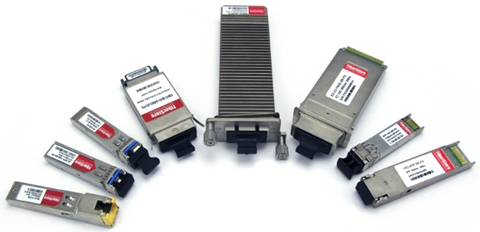Owing to the rapid progresses made in fiber optical technology, more and more networking infrastructure installations and upgrades choose fiber optic links for high-data-rate transmission. There is no question that compared with copper solutions, fiber optics provides greater bandwidth, more reliable data transmission, and immunity to electromagnetic interference and radio-frequency interference (EMI/RFI), crosstalk, impedance problems, and more. For constituting such fiber optic links, fiber optic module, one of the fast-growing transmission components, are instrumental, and work well in these applications where high-bandwidth and long-distance transmission are needed.
Along with the fiber optical technology advances, fiber optic module has been constantly designed and reinnovated, so as to better facilitate electrical-optical-electrical signal conversion. They are classified into several categories according to different standards regarding package, transmission mode, data rate and power supply. This text will talk about every classification standard in details.
MSAs (Multi-Source Agreements) are agreements between multiple manufacturers, system integrators, and suppliers, specifying parameters for system components and their guideline values, such as the electrical and optical interfaces, mechanical dimensions and electro-magnetic values. The equipment vendors follow these MSA defined values for designing their systems to ensure interoperability between interface modules. The form-factor or the MSA-type is needed so that the transceiver can mechanically and electrically fit into a given switch, router, etc. Transceiver MSAs define mechanical form factors including electric interface as well as power consumption and cable connector types. There are various MSA types: SFP (eg. E1MG-TX), SFP+, QSFP and so on.

When talking about this standard, single mode optical modules and multi-mode optical modules come to the central point.
- Single Mode Fiber Optic Module
Single-mode optical modules, or single-mode transceivers, just as their name show, are designed to work over single mode fibers (SMFs). Compared with multimode fiber (MMF), SMF fiber core is smaller and the wavelength of the laser is narrower, meaning that while transmitting optical signals, SMF is able to deliver higher bandwidth at the much longer distances, like 2km, 10km, 40km, 60km, 80km and 120km transmission. Commonly-seen single-mode transceiver types include 10GBASE-LR, 1000BASE-LR, 1000BASE-BX, etc..
- Multimode Fiber Optic Module
Multimode optical modules, or multimode transceivers, operate over MMF which uses a much bigger core and usually uses a longer wavelength of light. Thus, the optics used in MMF has a higher capability to gather light from the laser, for short distance transmission, with distance reach ranging from 100m to 500m. 10GBASE-SR is one of the most widely-used multi-mode transceiver types, such as AFBR-703SDZ-IN2. This Avago Intel compatible 10GBASE-SR SFP+ transceiver listed in FS.COM works over MMF with 850nm laser light for 300m distance reach.

- The connection between two network devices is realized with the help of protocols. It is imperative to know which protocol and data rate the switch or router supports. There are various protocols such as Ethernet, Fiber Channel (FC), InfiniBand, SONET/SDH, CPRI and so on. Each of these protocols supports their own data rates. For example Gigabit Ethernet (GbE) can range from 1Gb/s to 100Gb/s, while FC ranges from 1GFC (1.0625Gb/s) to 16GFC (14.025Gb/s).
- As for power supply, there are built-in switching power transceiver and eternal power supply transceiver. The built-in switching power transceiver is designed for the carrier grade power. It supports equipment power protection, filters, and a wide power supply voltage regulator, reducing the external point of failure arising from the mechanical contact. By contrast,the external power supply transceiver is made for multi-use civilian equipment, and it is compact and cheap.
- Of course, the classification standards of fiber optic module is not limited to those three points mentioned above. Other standards are also workable, such as the network management standard. It’s known that there are managed optical modules and unmanaged optical modules. The former type allows additional network monitoring with fault detection, free from configuration function. By contrast, the latter, without monitoring function, allows automatic communication of the devices that are connected to unmanaged optical modules.
When your networking projects call for fiber optic module for fiber optic links, these classification standards will work, since they help you to choose the right fiber optic modules for applications to ensure the reliable data transmission. FS.COM offers an ocean of fiber optic modules which are fully compatible with major brands, including the Brocade E1MGTX, and Avago Intel AFBR-703SDZ-IN2 mentioned above.
